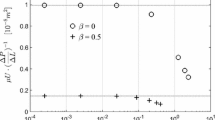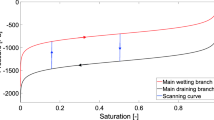Abstract
Practical expressions are given for the nine components of the block-scale permeability tensor of a thin block. These expressions are derived from the local-scale continuity equation and Darcy's law in an anisotropic layered porous medium. The flow problem is separated in a bottom-flux problem and a top-flux problem, both of which can be solved in essentially the same way. The bottom-flux problem has been worked out in detail, and has been separated in two parts: a vertical potential difference and a horizontal potential difference part. Each is solved with a different approach specially designed for it. Depth-averaged expressions are obtained first, after which block-scale expressions are obtained by assuming a constant depth-averaged flux. In the zeroth order, this results in the well-known Dupuit approximation in geohydrology, and the vertical equilibrium (VE) approximation in petroleum reservoir engineering. The novelty of the theory presented here stems from the application of a perturbation technique to obtain first-order corrections to these well-known results. The local-scale laws are applied in the coordinate system coinciding with the principal axes of the local-scale permeability tensor. Only in this coordinate system the local-scale permeability tensor has zero off-diagonal components. However, since the porous medium is imperfectly layered, the first-order corrections show that the off-diagonal components of the block-scale permeability tensor are not zero. Furthermore, the block-scale permeability tensor is generally nonsymmetric, which implies that a coordinate system in which the off-diagonal terms disappear does not exist.
Similar content being viewed by others
References
Ababou, R., 1988, Three-Dimensional Flow in Random Porous Media: Ph.D. thesis, Massachusetts Institute of Technology, Department of Civil Engineering, Cambridge, Massachusetts.
Aziz, K., and Settari, A., 1979, Petroleum Reservoir Simulation: Applied Science Publishers Ltd., London.
Bear, J., and Verruijt, A., 1987, Modeling Groundwater Flow and Pollution: With Computer Programs for Sample Cases: D. Reidel Publishing Company, Dordrecht.
Begg, S. H., and King, P. R., 1985, Modelling the Effects of Shales on Reservoir Performances: Calculation of Effective Vertical Permeability: SPE 13529.
Dagan, G., 1989, Flow and Transport in Porous Formations: Springer-Verlag, Berlin-Heidelberg.
Gelhar, L. W., 1986, Stochastic Subsurface Hydrology from Theory to Applications: Water Res. Res., v. 22, n. 9, p. 135S-145S.
Gelhar, L. W., and Axness, C. L., 1983, Three-Dimensional Stochastic Analysis of Macrodispersion in Aquifers: Water Res. Res., v. 19, n. 1, p. 161–180.
Kasap, E., and Lake, L. W., 1989, An Analytical Method to Calculate the Effective Permeability Tensor of a Grid Block and Its Application in an Outcrop Study: SPE 18434.
Kasap, E., and Lake, L. W., 1990, Calculating the Effective Permeability Tensor of a Grid Block: SPE Formation Evaluation, p. 192–200.
King, P. R., 1987, The Use of Field Theoretic Methods for the Study of Flow in a Heterogeneous Porous Medium: J. Phys. A: Math. Gen., v. 20, p. 3935–3947.
King, P. R., 1989, The Use of Renormalization for Calculating Effective Permeability: Trans. Porous Media, v. 4, p. 37–58.
Lehner, K., 1979, A Derivation of the Field Equations for Slow Viscous Flow Through a Porous Medium: Ind. Eng. Chem. Fundam., v. 18, no. 1, p. 41–45.
Morse, P. M., and Feshbach, H., 1953, Methods of Theoretical Physics: McGraw-Hill, New York.
Quintard, M., and Whitaker, S., 1987, Écoulement Monophasique en Milieux Poreux: Effet des Hétérogénéïtés Locales: J. de Mécanique Théorique et Appliquée (J. Theoret. Appl. Mech.), v. 6, n. 5, p. 691–726.
Russo, D., 1992, Upscaling of Hydraulic Conductivity in Partially Saturated Heterogeneous Porous Formation: Water Res. Res., v. 28, n. 2, p. 397–409.
Stam, J. M. T., and Zijl, W., 1992, Modeling Permeability in Imperfectly Layered Porous Media II: A Two-Dimensional Application of Block-Scale Permeability: Math. Geol., v. 24, n. 8, p. 885–904.
Van Dyke, M., 1975, Perturbation Methods in Fluid Mechanics: The Parabolic Press, Stanford.
White, C. D., and Horne, R. N., 1987, Computing Absolute Transmissibility in the Presence of Fine-Scale Heterogeneity: SPE 16011.
Yortsos, Y. C., 1991, A Theoretical Analysis of Vertical Flow Equilibrium: SPE 22612.
Zapata, V. J., and Lake, L. W., 1981, A Theoretical Analysis of Viscous Crossflow: SPE 10111.
Zijl, W., 1984, Finite Element Methods Based on a Transport Velocity Representation for Groundwater Motion: Water Res. Res., v. 20, n. 1, p. 137–145.
Author information
Authors and Affiliations
Rights and permissions
About this article
Cite this article
Zijl, W., Stam, J.M.T. Modeling permeability in imperfectly layered porous media. I. Derivation of block-scale permeability tensor for thin grid-blocks. Math Geol 24, 865–883 (1992). https://doi.org/10.1007/BF00894656
Received:
Issue Date:
DOI: https://doi.org/10.1007/BF00894656




